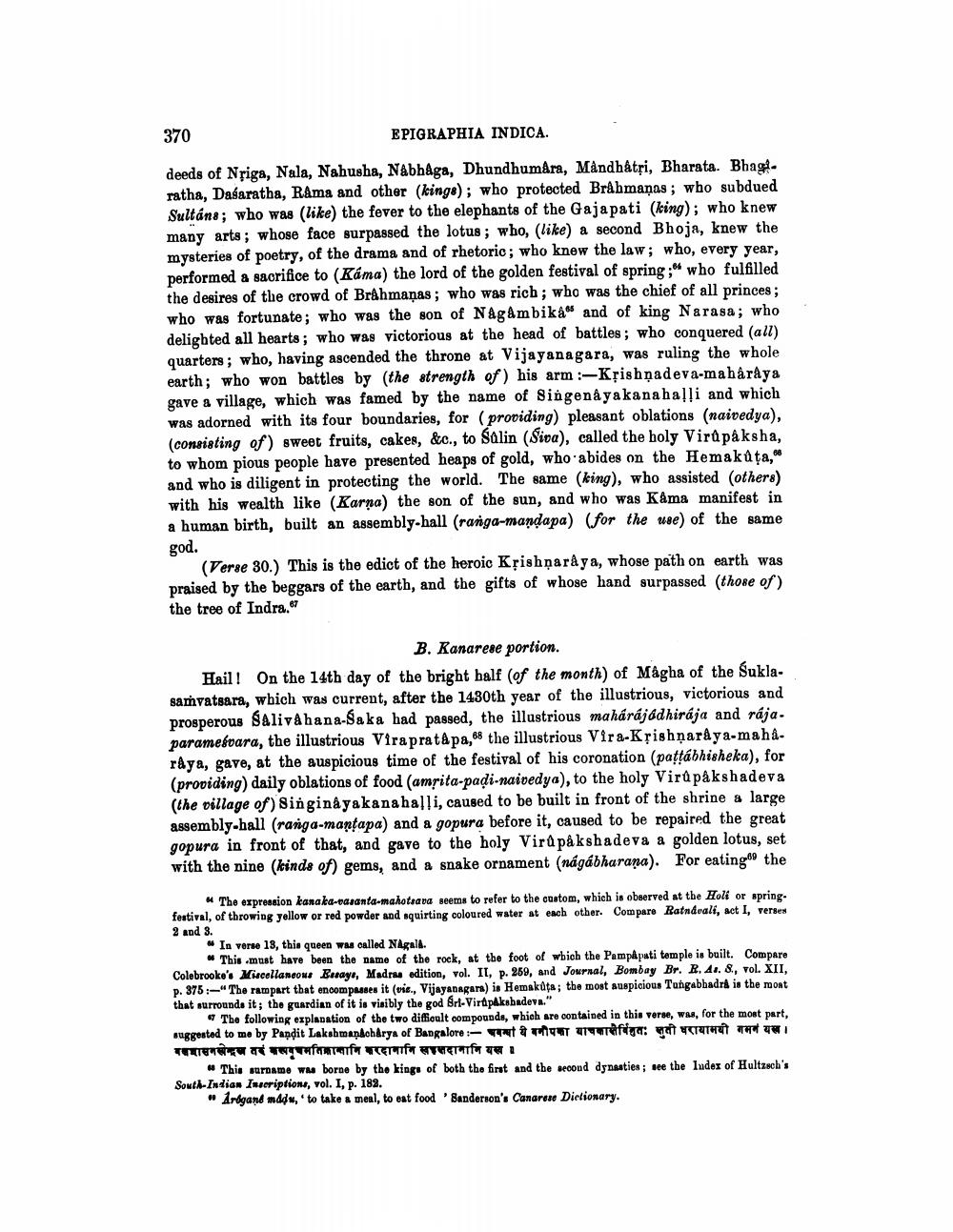________________
370
EPIGRAPHIA INDICA.
deeds of Nriga, Nala, Nahusha, Nábhaga, Dhundhumara, Mandhåtři, Bharata. Bhagt. ratha, Dabaratha, Rama and other (keinge); who protected Brahmanas; who subdued Sultáns; who was (like) the fever to the elephants of the Gajapati (king); who knew many arts; whose face surpassed the lotus ; who, (like) a second Bhoja, knew the mysteries of poetry, of the drama and of rhetoric; who knew the law; who, every year, performed a sacrifice to (Káma) the lord of the golden festival of spring;" who fulfilled the desires of the crowd of Brahmaņas; who was rich; who was the chief of all princes; who was fortunate; who was the son of Någambika" and of king Narasa; who delighted all hearts; who was victorious at the head of battles; who conquered (all) quarters; who, having ascended the throne at Vijayanagara, was ruling the whole earth; who won battles by (the strength of his arm :-Krishnadeva-maharaya gave a village, which was famed by the name of Singenâ yakanahalli and which was adorned with its four boundaries, for providing) pleasant oblations (naivedya), (consisting of) sweet fruits, cakes, &c., to Salin (Siva), called the holy Virapaksha, to whom pious people have presented heaps of gold, who abides on the Hemakūta, and who is diligent in protecting the world. The same (king), who assisted (others) with his wealth like (Karna) the son of the sun, and who was Kama manifest in a human birth, built an assembly-hall (ranga-mandapa) (for the use) of the same
god.
(Verse 30.) This is the edict of the heroic Kệishṇaraya, whose path on earth was praised by the beggars of the earth, and the gifts of whose hand surpassed (those of) the tree of Indra.
B. Kanarese portion. Hail! On the 14th day of the bright half of the month) of Mågha of the Suklasamvatsara, which was current, after the 1430th year of the illustrious, victorious and prosperous Saliva hana-Saka had passed, the illustrious mahárájádhiraja and rája. parameboara, the illustrious Vira prat& pa,88 the illustrious Vira-Krishṇaraya-maharaya, gave, at the auspicious time of the festival of his coronation (pattábhisheka), for (providing) daily oblations of food (amrita-padi-naivedya), to the holy Virupakshadeva (the village of) Singinayakanahalli, caused to be built in front of the shrine a large assembly-ball (ranga-mantapa) and a gopura before it, caused to be repaired the great gopura in front of that, and gave to the holy Vira på kshadeva a golden lotus, set with the nine (kinds of) gems, and a snake ornament (nágábharana). For eating the
# The expression kanaka-rasanta-mahotsava seems to refer to the custom, which is observed at the Holi or spring festival, of throwing yellow or red powder and squirting coloured water at each other. Compare Ratnávali, act I, verses 2 and 3.
"In verse 13, this queen was called Nagala.
"This.must have been the name of the rock, at the foot of wbich the Pamp&pati temple is built. Compare Colebrooke's Miscellaneous Essays, Madras edition, vol. II, p. 269, and Journal, Bombay Br. R. 41. &, vol. XII, p. 375:- The rampart that encompasses it (vis., Vijayanagara) is Hemakūta; the most auspicious Tungabhadra is the most that surrounde it; the guardian of it is visibly the god Brt-Virtpakabadeva."
The following explanation of the two difficult compounds, which are contained in this verse, was, for the most part, suggested to me by Pandit Lakshmandoharya of Bangalore : &
m u trefya ya TATIT TWI बसमासनसन्दालत बलवृधमतिकाबानि बरदानानि सासदानानि यस ।
# This surname was borne by the kings of both the first and the second dynasties; see the ludex of Hultzsch's South Indian Inscriptions, vol. I, p. 182.
"Arigand add to take a meal, to eat food 'Sanderson's Canarese Dictionary.




